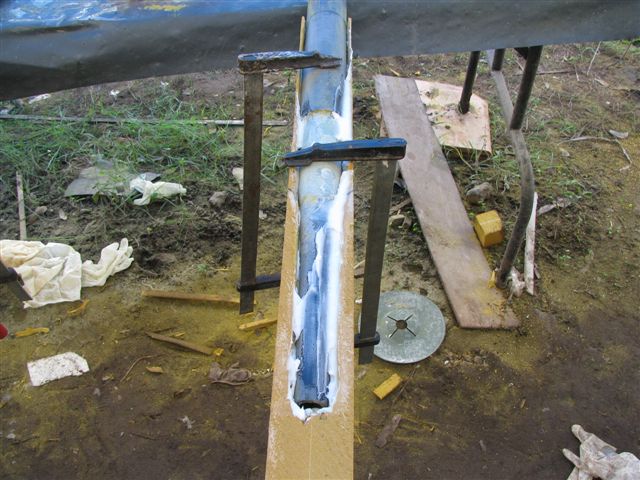 |
The designer is notorious for drawing rudders
that aren't big enough to work for low speed navigation but not
long ago the mag Good Old Boat had a brilliant tech article (as
they do) on rudder design which gave me the courage to wing it.
The dotted line indicates about the designed
dimension. The rudder shaft position was also moved to balance
the rudder.. hopefully. I talked
to the skipper of another boat of similar design who after ten
years of putting up with the smaller size, added the width as
I have shown here but not the depth. Also he couldn't move the
rudder shaft position. Even so his first sail produced a favourable
result. He and his mate found much better response at the helm.
|
 |
This is PVC closed cell foam of 120
kg (means one cubic metre weights 120 kilograms). Very dense.
The designer offered to order me a set
of carbon fibre rudder stocks and tubes, both arrived short of
required length... OK... So, I used one of the handline stanchions
that came along as well, and spliced it into the stock, about
double what the correct extension would have been to accommodate
the extra rudder size.
I cut the foam to fit the stock and buried
in glue mix and.... |
 |
With the glue mix going firm and the
leading edge ready to go... |
 |
Filled the area and the leading edge
part as well. |
 |
Whatever works.. |
 |
Then I marked my profile bottom and...
UPDATE! Here is where
I made mistake number 1. See the second line marking the trailing
edge on the profile on the bottoms? That is where the trailing
edge should have started and the leading edge should have been
brought back accordingly. The rudder shaft centre should be about
17% back from the leading edge for best feel. Some racing boats
prefer as little as 12% from the leading edge. My final shape
comes out to about 19.8%. I asked Bob Burgess what he thought
and upon siting them he reckons they are worth a try and I think
he is right. If after sea trials I find the helm trying to "seek"
her own course, I'll spend a day on the beach reshaping by bringing
the lower half of the leading edge back toward the stock. |
 |
top... and... |
 |
using my 7 inch sander mounted with
a very sharp 36 grit pad, cut to the lines as shown. This gave
me a good reference point to work from. I used a normal wood
saw to cut off the material that made the taper toward the bottom
so now I have my outline all around. Part tracing what I had
drawn on paper (top and bottom) and the edges pretty much freehand. |
 |
another view.. |
 |
Then clamped it down and went at it. |
 |
There is the rough shape. |
 |
And then round off the corners
for flow and to allow the glass to follow the contour. |
 |
The trailing edge was left a bit blunt
and now use a glue mix to build it up. when hard I ground it
to match the contour. |
 |
With the trailing edge shaped I can
laminate without having to bring the cloth around the trailing
edge and still be assured of a seal to the core material. Not
that foam is as vulnerable as balsa but still better to do this
way.
UPDATE # 2! Bill and
Malcolm Salisbury caught this one (thanks you two!). I was depending
on the roughly shaped filler around the rudder stock to keep
everything together under torque load but the experts said, "not
enough" and Bob Burgess agreed so... see photos on the modification
at bottom of the page. Really easy anyway. Wish all my problems
were as easy to fix |
 |
450 gr DB (double bias) is easy to wet
and flexible, but not tough enough so two layers of it. Gift
wrapping experience helps here. Making tidy folds is important.
The top and bottom have 8 layers of the glass after the folding
process. If it resists folding and laying down, just let it go
a little gel and sticky and then try it but must get any air
out! |
 |
etc.. |
 |
This was a hot day so very exciting! |
 |
When the resin as going firm, lay on
the bog... |
 |
This is the pair sanded off and ready
to paint. The funny blue colour is because of the blue poly tarp
that was overhead. |
|
The Following
are updated photos of the repair to strengthen the rudders. |
 |
First the matter
of the rudder stock balance. If I had the stock about 5mm ahead
it would be spot on but we'll see later. |
 |
This is what can
happen when you go borrowing tools from neightbours... I just
asked for a long drill! I wasn't going for bloody oil! But beggars
can't be choosers...
I drilled a half inch
hole right through the leading edge and well past the stock and
being very careful to keep alignment. |
 |
Did one at an angle
back to anchor more of the lower rudder. |
 |
I happened to have
some 14mm (9/16th) fibreglass rod. I undercut the area around
the holes carefully to eliminate all the foam for about 3/8 inch
(10mm) all round. I cut the rod so it would recess in an equal
amount and inserted them after the next step. With the rudders
at about a 45 degree angle, I filled the holes and the part of
the stock that was involved, with resin thickened with cab-o-sil
glue mix, dropped in the rods. Then with a thicker mix capped
the holes, let set and ..... |
 |
That is what it looks
like done. |
|
|
|
|
|
|

